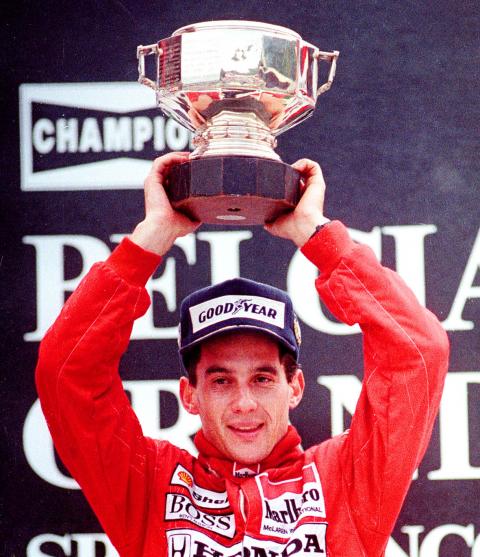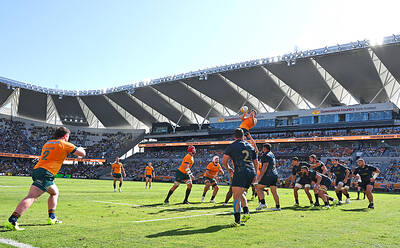The death of Ayrton Senna 25 years ago changed Formula One’s (F1) attitude toward safety to such an extent that only one driver, Jules Bianchi in 2014, has since suffered a fatal accident.
In 1994, F1 had gone eight years without a death. After 10 drivers died in the 1970s, only four were killed in the 1980s — the last to die was Elio de Angelis in 1986.
Then came the black weekend in Imola, Italy, at the start of May 1994 when Roland Ratzenberger died in qualifying on Saturday and Senna in the race on Sunday. Those deaths rocked the drivers and the governing body of international motorsports, the Federation Internationale de l’Automobile (FIA).

Photo: Reuters
“We got too confident that the dangerous times were over,” Senna’s former teammate, Gerhard Berger, said. “We realized that it had not changed at all and that we had been lucky for a while. That shook the FIA, the teams, the drivers. After this, everybody joined forces together with the FIA in the lead and it came to a very good result.”
An Italian court blamed a rupture in a hastily adapted steering column for Senna’s crash.
“Regardless of whether that steering column caused the accident or not, there is no escaping the fact that it was a bad piece of design that should never have been allowed to get on the car,” Adrian Newey, who helped design the car and is considered the best F1 engineer, wrote in his 2017 autobiography.
He also wrote that the crash was linked to the instability of the Williams car.
After the car hit a concrete wall at the Tamburello corner of the Imola circuit at more than 200kph, the right front wheel and suspension were hurled into the cockpit. A piece of metal hit Senna’s head and killed him.
In the following days, drivers — including Michael Schumacher, Niki Lauda and Berger — reformed the Grand Prix Drivers’ Association and called for a reduction in speed, which was introduced for the Spanish Grand Prix at the end of May. By the Canadian Grand Prix in the middle of June, the cockpit had been lengthened and reinforced, and the suspension strengthened.
The next season, 1995, brought higher norms for crash tests. In 1996, the protection round the driver’s head was reinforced. In 1998, the wheels were attached to the car by tethers to stop them from flying off.
A head and neck support system, which attaches the helmet to the shoulders and is designed to protect the spine, was introduced in 2003. It was followed last season by a halo to protect the head.
Senna’s crash also changed attitudes toward track layout.
In 1995, the Tamburello was remodeled into a serpentine curve. More than a third of the courses on this year’s F1 calendar are “Tilkedromes”: tracks designed or renovated since 1995 by the German engineer Hermann Tilke. They are wider, have bigger run off areas on the curves and move the fans farther away.
Senna’s death also altered the attitude of the public.
“The biggest difference between the death of Jim Clark on April 7, 1968, and Ayrton Senna on May 1, 1994, is that the world needed to know the answers as to why it had happened — why is this man dead, why is motor racing so dangerous?” Maurice Hamilton, long-time motorsports correspondent for the Observer, said in 1: Life on the Limit, a 2013 documentary on the history of safety in the sport.
“The death of Ayrton Senna was relayed by television in the living rooms of millions of people around the world, to people who didn’t really know about motor racing, but knew of him. Somebody had to be blamed,” Hamilton added.

The Kansas City Chiefs wrapped up a brief visit to Brazil on Friday with a season-opening loss to the Los Angeles Chargers, but despite the defeat, the team outshone their divisional rivals in the fight for the hearts and minds of Brazilian fans. In Sao Paulo for just the second-ever NFL game in the city, Chiefs players — especially quarterback Patrick Mahomes and tight end Travis Kelce — were treated as major celebrities throughout their stay, turning Corinthians Arena into a scene reminiscent of the Chiefs’ Arrowhead Stadium. Before kickoff, crowds of fans gathered around the Chiefs’ tunnel, eager to catch a

New Zealand stayed firm at their Eden Park fortress to claim an attritional 24-17 win over South Africa in a heavyweight clash between the world’s top two rugby sides yesterday. Under pressure after conceding a first-ever defeat on Argentine soil against the Pumas two weeks ago, the All Blacks responded with a performance of grit and discipline to stretch their unbeaten run at their Auckland stronghold to 51 matches. Two well-taken tries by Emoni Narawa and Will Jordan set up a 14-3 lead at halftime before Quinn Tupaea grabbed a third five-pointer for the hosts 13 minutes from time. Well-held for most of

Mikel Merino on Sunday scored a hat-trick as a majestic Spain thumped Turkey 6-0 away in World Cup qualifying, while a brilliant Florian Wirtz free-kick helped Germany beat Northern Ireland 3-1 to get their bid up and running. European champions Spain were in unstoppable form in the central Turkish city of Konya, claiming their second biggest-ever away win in World Cup qualifying as Arsenal midfielder Merino scored his first professional hat-trick. Barcelona playmaker Pedri Gonzalez opened the scoring inside six minutes and later completed the scoring, with Ferran Torres netting the visitors’ other goal. The quality of Merino’s strikes was remarkable, with his

The Wallabies trusted their instincts to keep pushing for a late try instead of a potential equalizing penalty goal late in their Rugby Championship Test match yesterday against Argentina, with prop Angus Bell scoring the clinching try in the sixth minute of added time to give Australia a comeback 28-24 win. The Wallabies were awarded three kickable penalties after the 80th minute, but kept pushing in search of the match-winning try, which was finally delivered by an unlikely hero in reserve prop Bell. “It’s just relieving,” Bell said. “It’s just awesome we could get the win in the end; not go for